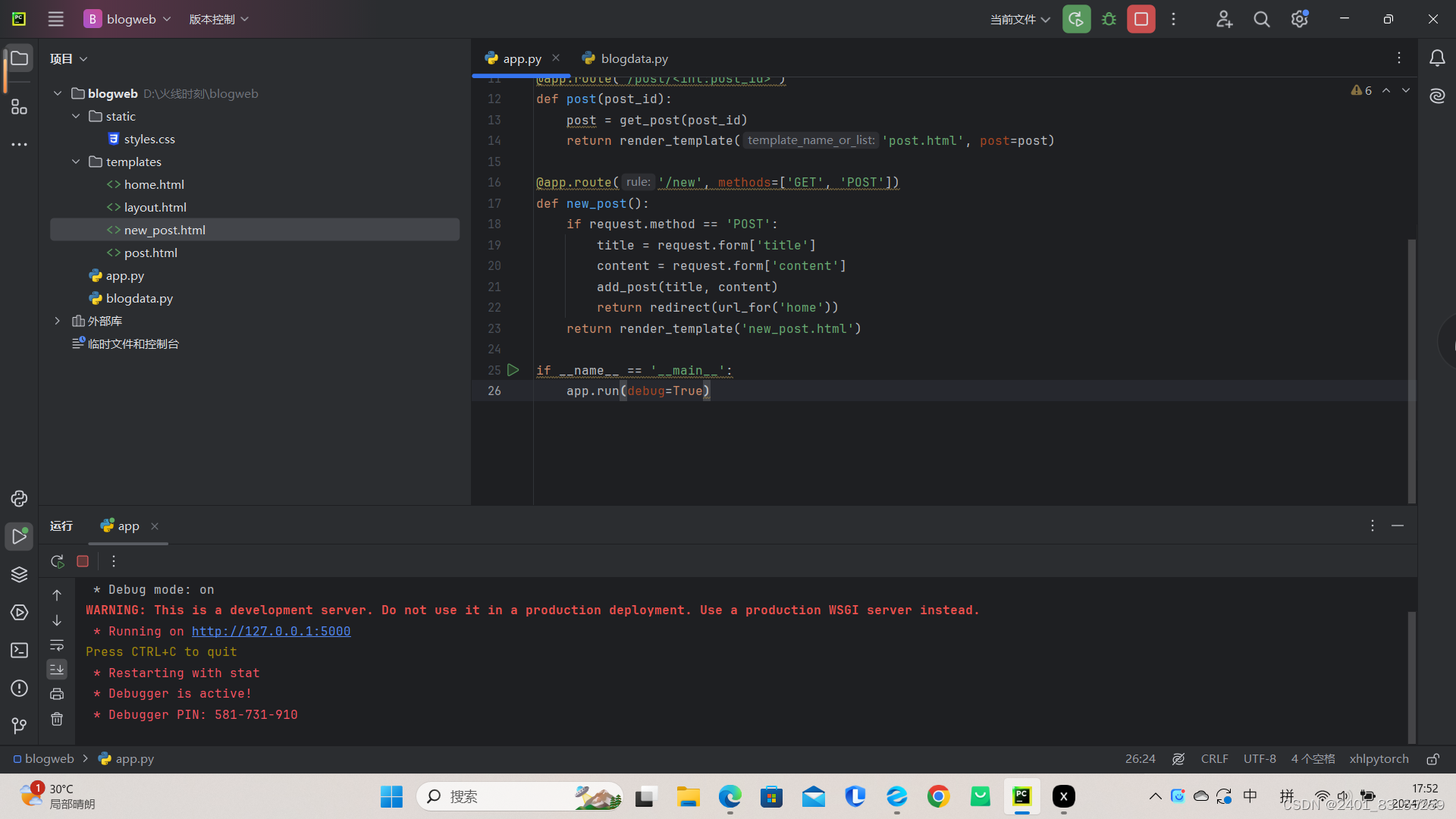总体的设计思路
设计网页的思路涉及多个方面,从前端的页面结构和样式,到后端的数据处理和逻辑实现。
1.确定网站的需求和功能
首先要明确网站的功能需求,比如用户注册登录、博客文章发布和展示、评论系统等。
2.选择技术栈
选择适合的框架和工具。对于Python,常用的Web框架包括Flask和Django。
3. 设置项目结构
合理的项目结构有助于组织代码,方便后续的维护和扩展。
4. 前端设计
前端主要负责网页的展示和用户交互,可以使用HTML、CSS和JavaScript。
5. 后端设计
后端负责业务逻辑处理、数据库操作、用户验证等。
6. 数据库设计
设计数据库模型,确定需要存储的数据及其关系。
7. 集成前后端
通过API接口将前端和后端集成起来,实现数据的交互。
8. 测试和部署
进行充分的测试,确保功能和性能满足需求,然后部署到服务器上。
实操应用
我们可以使用Flask框架来实现一个简单的博客网站。
步骤1:安装Flask
首先,你需要安装Flask。可以使用pip来安装:
pip install flask步骤2:创建项目结构
创建一个项目目录,结构如下:
my_blog/├── static/│ └── styles.css├── templates/│ ├── layout.html│ ├── home.html│ └── post.html| └── new_post.html├── app.py└── blogdata.py步骤3:设置Flask应用
在app.py中编写以下代码:
from flask import Flask, render_template, request, redirect, url_forfrom blogdata import get_posts, get_post, add_postapp = Flask(__name__)@app.route('/')def home(): posts = get_posts() return render_template('home.html', posts=posts)@app.route('/post/<int:post_id>')def post(post_id): post = get_post(post_id) return render_template('post.html', post=post)@app.route('/new', methods=['GET', 'POST'])def new_post(): if request.method == 'POST': title = request.form['title'] content = request.form['content'] add_post(title, content) return redirect(url_for('home')) return render_template('new_post.html')if __name__ == '__main__': app.run(debug=True)步骤4:创建博客数据处理
在blogdata.py中模拟一些博客数据及操作:
posts = [ { 'id': 1, 'title': 'First Post', 'content': 'This is the content of the first post.' }, { 'id': 2, 'title': 'Second Post', 'content': 'This is the content of the second post.' }]def get_posts(): return postsdef get_post(post_id): for post in posts: if post['id'] == post_id: return post return Nonedef add_post(title, content): new_post = { 'id': len(posts) + 1, 'title': title, 'content': content } posts.append(new_post)步骤5:创建HTML模板
在templates目录下创建以下HTML文件:
layout.html
<!doctype html><html lang="en"><head> <meta charset="UTF-8"> <meta name="viewport" content="width=device-width, initial-scale=1.0"> <title>我的博客</title> <link rel="stylesheet" href="{{ url_for('static', filename='styles.css') }}"></head><body> <header> <h1>我的博客</h1> <nav> <a href="{{ url_for('home') }}">Home</a> <a href="{{ url_for('new_post') }}">New Post</a> </nav> </header> <main> {% block content %}{% endblock %} </main> <footer> <p>© 2024 我的博客</p> </footer></body></html>home.html
{% extends 'layout.html' %}{% block content %} <h2>Blog Posts</h2> <ul> {% for post in posts %} <li> <a href="{{ url_for('post', post_id=post.id) }}">{{ post.title }}</a> </li> {% endfor %} </ul>{% endblock %}post.html
{% extends 'layout.html' %}{% block content %} <h2>{{ post.title }}</h2> <p>{{ post.content }}</p> <a href="{{ url_for('home') }}">Back to Home</a>{% endblock %}new_post.html
{% extends 'layout.html' %}{% block content %} <h2>New Post</h2> <form method="POST"> <div> <label for="title">Title:</label> <input type="text" id="title" name="title"> </div> <div> <label for="content">Content:</label> <textarea id="content" name="content"></textarea> </div> <button type="submit">Add Post</button> </form>{% endblock %}步骤6:创建样式文件
在static目录下创建styles.css
body { font-family: Arial, sans-serif; margin: 0; padding: 0; background-color: #f4f4f4;}header { background-color: #333; color: white; padding: 1rem; text-align: center;}nav a { color: white; margin: 0 1rem; text-decoration: none;}main { padding: 2rem;}footer { text-align: center; padding: 1rem; background-color: #333; color: white; position: fixed; bottom: 0; width: 100%;}运行Flask应用
最后,在pycharm中运行app.py
打开浏览器,访问http://127.0.0.1:5000,你就可以看到你创建的博客网页了。